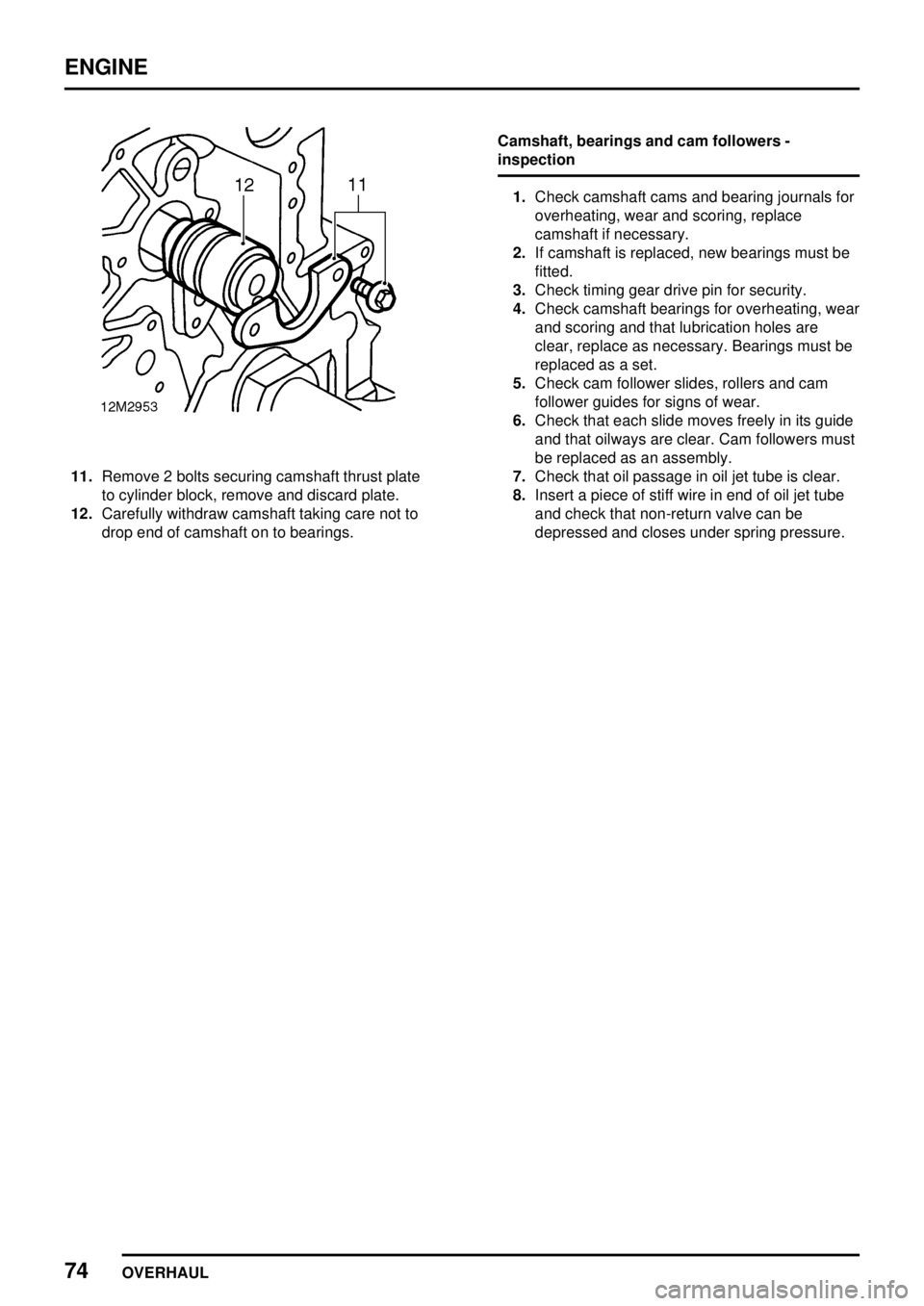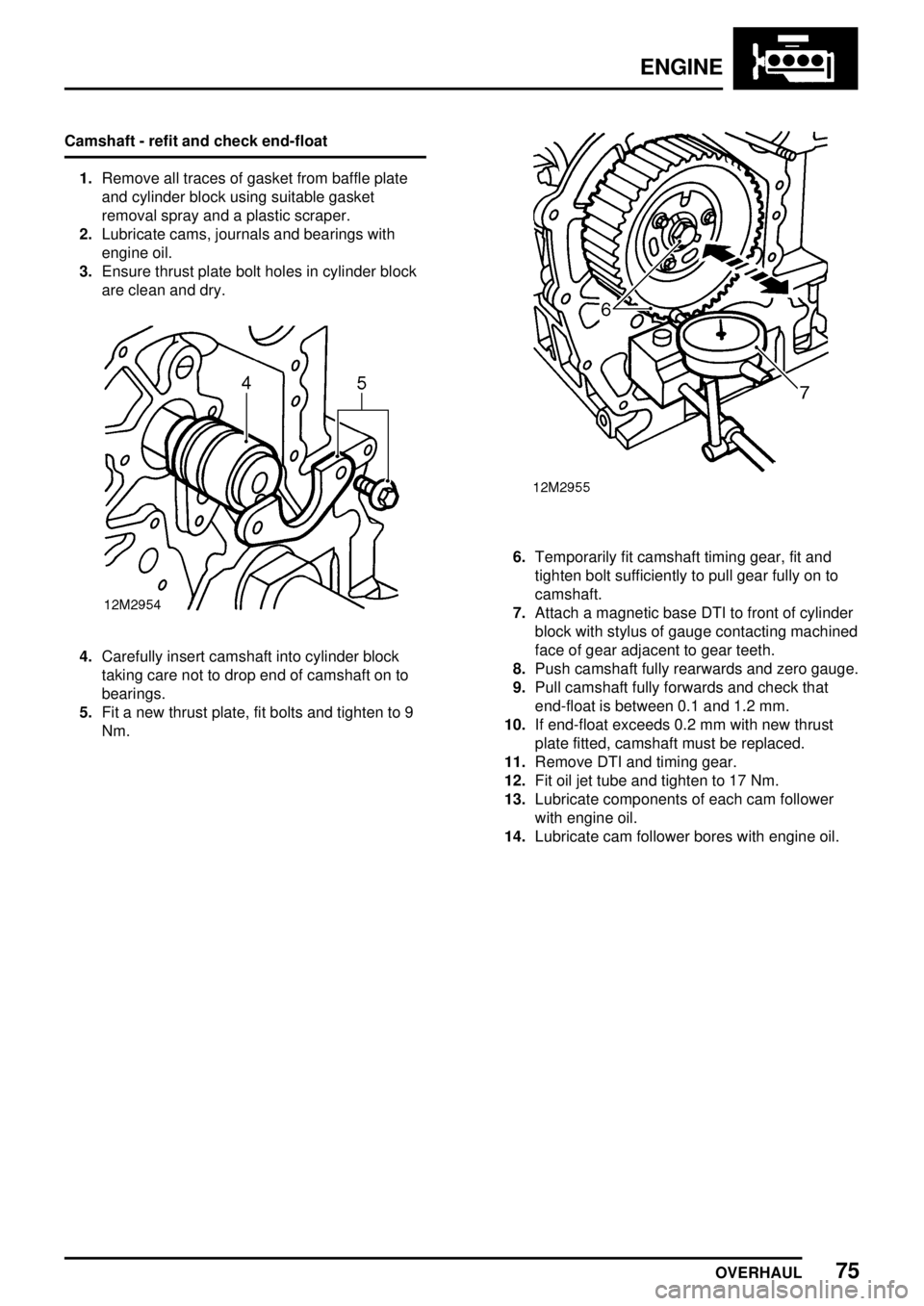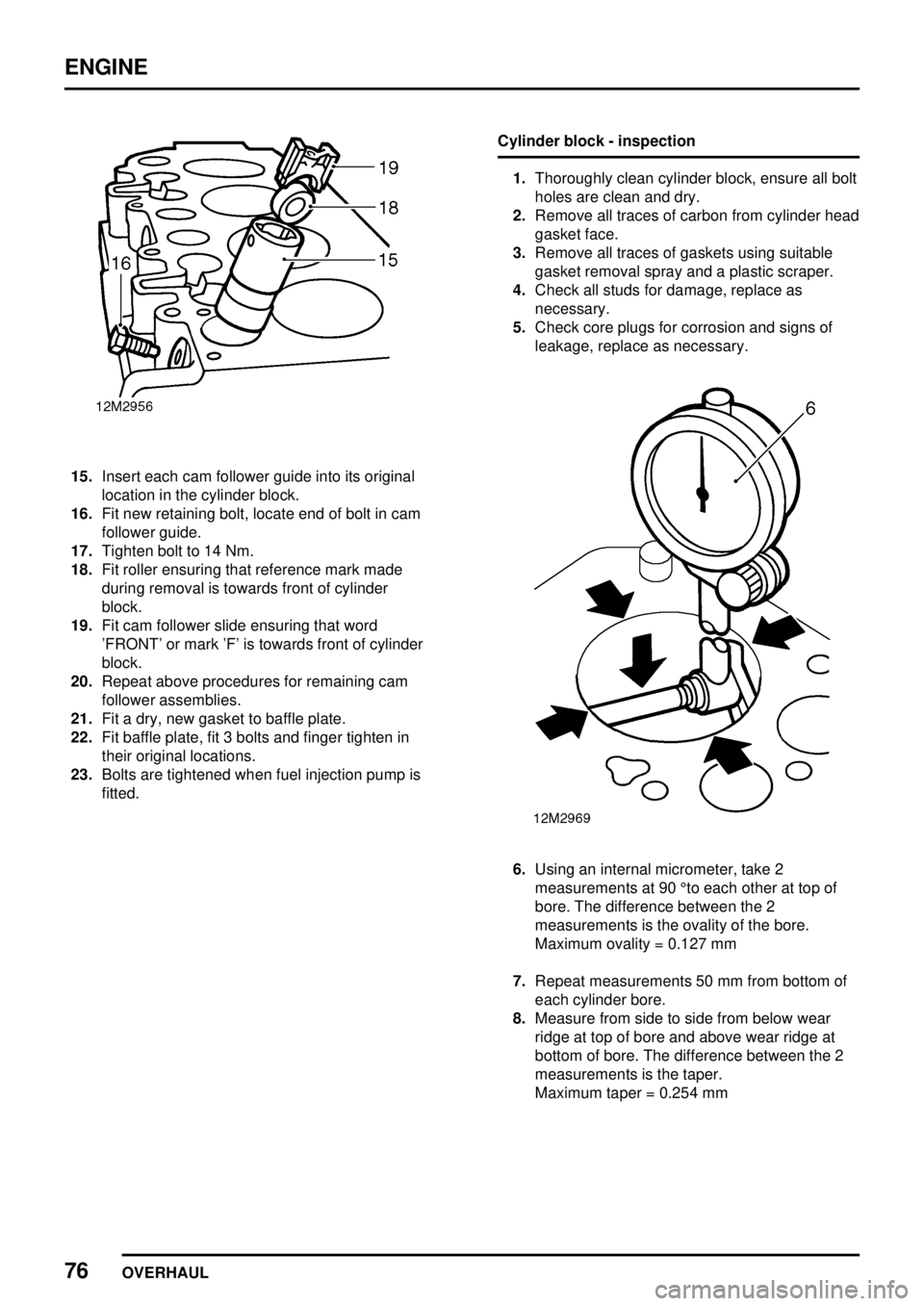Page 964 of 976
ENGINE
OVERHAUL69
11.Assemble each big-end bearing cap less
bearing shells to its respective connecting rod.
12.Fit and tighten big-end bearing cap nuts to 59
Nm.
13.Slacken the nut on one side of connecting rod.
14.Using feeler gauges, check that there is no gap
between bearing cap and connecting rod on
the side of the cap with the slackened nut.
CAUTION: If clearance exists, connecting
rod must be replaced.
15.Remove nuts and big-end bearing caps.
CAUTION: Retain nuts and bearing caps
with their respective connecting rod
16.Repeat above procedures for remaining
connecting rods.17.Lubricate gudgeon pins and small end bushes
with engine oil.
18.Assemble each connecting rod and gudgeon
pin to its respective piston ensuring that
bearing tag recess on connecting rod is on
correct side of piston.
19.Fit new circlips to retain gudgeon pins ensuring
they are correctly seated in their grooves.
Page 965 of 976
ENGINE
70
OVERHAUL Piston rings - checking
CAUTION: Prior to checking piston ring
gaps in cylinder bores, bores must be
inspected, measured and if reboring has
been carried out, the appropriate oversize
pistons and rings used.
1.Check fitted gap of each new piston ring in turn
with ring positioned half-way down cylinder
bore.
Fitted gap of rings in bores:
Top compression = 0.40 to 0.65 mm
2nd compression = 0.30 to 0.50 mm
Oil control rails = 0.30 to 0.60 mm
CAUTION: Ensure that piston rings are
suitably identified with the cylinder bore in
which they were checked and that they are
fitted to the piston for that cylinder bore.
2.Fit oil control rails and spring to piston.
3.Fit 2nd, narrow compression ring with 'TOP'
marking uppermost.
4.Fit top compression ring with 'TOP' marking
uppermost.
5.Check that rings are free to rotate in their
grooves.
Page 966 of 976
ENGINE
OVERHAUL71
6.Check ring to groove clearances:
Top compression = 0.167 to 0.232 mm
2nd compression = 0.05 to 0.08 mm
Oil control rails = 0.05 to 0.08 mm
7.If new ring to groove clearances are excessive,
new pistons must be fitted.Oil jet tubes - inspection
1.Check that oil passage in each oil jet tube is
clear.
2.Thoroughly clean banjo bolts.
3.Insert a piece of stiff wire in end of banjo bolt
and check that non-return valve can be
depressed to open position and returns to
closed position under spring pressure.
CAUTION: If non-return valve is not
working correctly, replace banjo bolt.
4.Check sealing washers for damage, replace as
necessary.
Page 967 of 976
ENGINE
72
OVERHAUL Pistons and connecting rods - refit
1.Position piston ring gaps at 60°to each other
and away from thrust side of piston (left hand
side of piston when viewed from front).
2.Slide suitable lengths of tubing over connecting
rod bolts.
3.Ensure cylinder bores are clean.
4.Lubricate pistons, rings and cylinder bores with
engine oil.
5.Compress piston rings using a suitable clamp.
6.Insert piston and connecting rod into cylinder
bore ensuring that piston is in its correct fitted
order and arrow on piston crown is towards
front of cylinder block.
7.Push piston into cylinder bore.
CAUTION: Ensure that connecting rods do
not contact cylinder bores. Do not pull
connecting rods fully down cylinder bores
at this stage.
8.Repeat above procedures for numbers 2 and 3
pistons and connecting rods.Oil jet tubes - refit
1.Position sealing washers in cylinder block.
2.Fit oil jet tubes to their original locations.
3.Fit banjo bolts and washers, tighten bolts to 17
Nm.
Page 968 of 976
ENGINE
OVERHAUL73
Camshaft - remove
1.Remove oil jet tube.
2.Clean area around baffle plate.
3.Note fitted position of 3 bolts securing baffle
plate.
4.Remove 3 bolts securing baffle plate to
cylinder block, remove plate.
5.Remove and discard gasket.
CAUTION: Do not remove cam follower
guide retaining bolts until slides and
rollers have been removed, keep
components of each cam follower assembly in
their fitted order.
6.Using long nosed pliers, remove cam follower
slide.
7.Remove roller and suitably identify which side
of roller faces towards front of cylinder block.
8.Remove and discard bolt retaining cam
follower guide.
9.Remove cam follower guide.
10.Repeat above procedures for remaining cam
follower assemblies.
Page 969 of 976

ENGINE
74
OVERHAUL
11.Remove 2 bolts securing camshaft thrust plate
to cylinder block, remove and discard plate.
12.Carefully withdraw camshaft taking care not to
drop end of camshaft on to bearings.Camshaft, bearings and cam followers -
inspection
1.Check camshaft cams and bearing journals for
overheating, wear and scoring, replace
camshaft if necessary.
2.If camshaft is replaced, new bearings must be
fitted.
3.Check timing gear drive pin for security.
4.Check camshaft bearings for overheating, wear
and scoring and that lubrication holes are
clear, replace as necessary. Bearings must be
replaced as a set.
5.Check cam follower slides, rollers and cam
follower guides for signs of wear.
6.Check that each slide moves freely in its guide
and that oilways are clear. Cam followers must
be replaced as an assembly.
7.Check that oil passage in oil jet tube is clear.
8.Insert a piece of stiff wire in end of oil jet tube
and check that non-return valve can be
depressed and closes under spring pressure.
Page 970 of 976

ENGINE
OVERHAUL75
Camshaft - refit and check end-float
1.Remove all traces of gasket from baffle plate
and cylinder block using suitable gasket
removal spray and a plastic scraper.
2.Lubricate cams, journals and bearings with
engine oil.
3.Ensure thrust plate bolt holes in cylinder block
are clean and dry.
4.Carefully insert camshaft into cylinder block
taking care not to drop end of camshaft on to
bearings.
5.Fit a new thrust plate, fit bolts and tighten to 9
Nm.
6.Temporarily fit camshaft timing gear, fit and
tighten bolt sufficiently to pull gear fully on to
camshaft.
7.Attach a magnetic base DTI to front of cylinder
block with stylus of gauge contacting machined
face of gear adjacent to gear teeth.
8.Push camshaft fully rearwards and zero gauge.
9.Pull camshaft fully forwards and check that
end-float is between 0.1 and 1.2 mm.
10.If end-float exceeds 0.2 mm with new thrust
plate fitted, camshaft must be replaced.
11.Remove DTI and timing gear.
12.Fit oil jet tube and tighten to 17 Nm.
13.Lubricate components of each cam follower
with engine oil.
14.Lubricate cam follower bores with engine oil.
Page 971 of 976

ENGINE
76
OVERHAUL
15.Insert each cam follower guide into its original
location in the cylinder block.
16.Fit new retaining bolt, locate end of bolt in cam
follower guide.
17.Tighten bolt to 14 Nm.
18.Fit roller ensuring that reference mark made
during removal is towards front of cylinder
block.
19.Fit cam follower slide ensuring that word
'FRONT' or mark 'F' is towards front of cylinder
block.
20.Repeat above procedures for remaining cam
follower assemblies.
21.Fit a dry, new gasket to baffle plate.
22.Fit baffle plate, fit 3 bolts and finger tighten in
their original locations.
23.Bolts are tightened when fuel injection pump is
fitted.Cylinder block - inspection
1.Thoroughly clean cylinder block, ensure all bolt
holes are clean and dry.
2.Remove all traces of carbon from cylinder head
gasket face.
3.Remove all traces of gaskets using suitable
gasket removal spray and a plastic scraper.
4.Check all studs for damage, replace as
necessary.
5.Check core plugs for corrosion and signs of
leakage, replace as necessary.
6.Using an internal micrometer, take 2
measurements at 90°to each other at top of
bore. The difference between the 2
measurements is the ovality of the bore.
Maximum ovality = 0.127 mm
7.Repeat measurements 50 mm from bottom of
each cylinder bore.
8.Measure from side to side from below wear
ridge at top of bore and above wear ridge at
bottom of bore. The difference between the 2
measurements is the taper.
Maximum taper = 0.254 mm